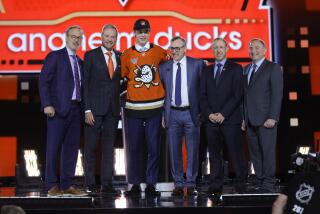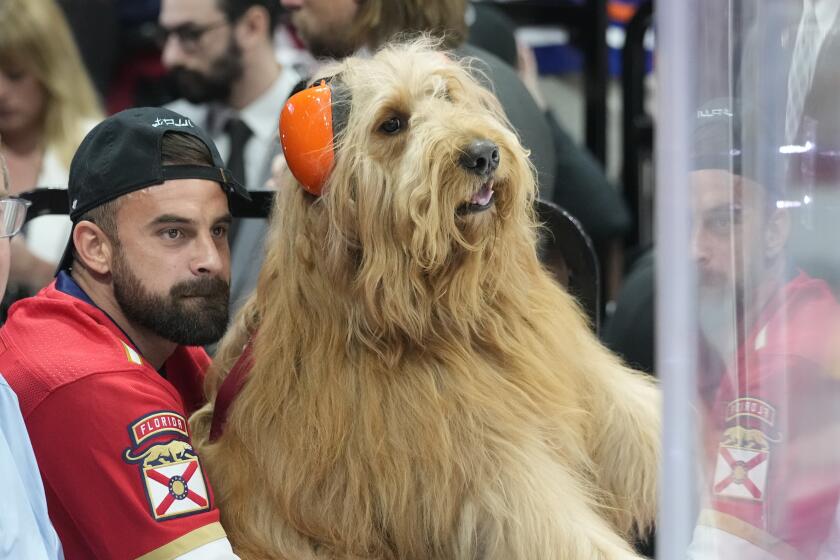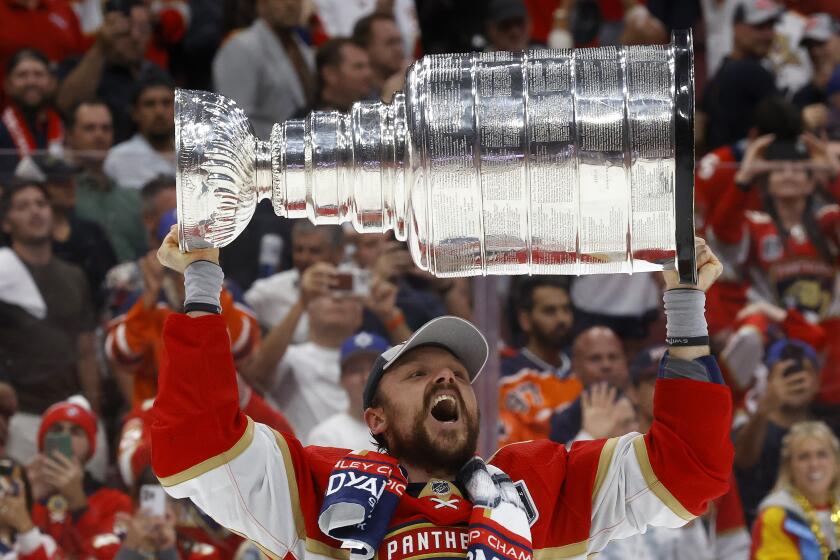No One Stays Neutral About Devils’ Trap : Hockey: Critics call it a negative ploy, but New Jersey has used it to good effect in the playoffs.
It’s either the scourge of the NHL or a stroke of genius.
It’s either “destroy hockey,” as Detroit Red Wing defenseman Viacheslav Fetisov disdainfully called it, or the ultimate strategy because its success depends on the discipline and selflessness of every player.
It’s the New Jersey Devils’ neutral zone trap, and no one who has seen it during the team’s march to the Stanley Cup finals remains neutral about it.
ESPN analyst Mike Milbury, a former NHL player and coach, said the trap should be banned because it’s a negative ploy that minimizes scoring, is too intricate to be appreciated by most fans and doesn’t play well on television at a time when the league is trying to attract new viewers.
But the Devils, who used the trap to muzzle Boston Bruin right wing Cam Neely, Pittsburgh Penguin right wing Jaromir Jagr and the Philadelphia Flyers’ potent “Legion of Doom” line, defend the trap as energetically as they have defended every inch of ice throughout the playoffs.
Thanks to their superb defense, they will take a 2-0 lead over the Red Wings into Game 3 of the finals tonight at the Meadowlands Arena.
“I’m real sick of hearing all the criticism. It’s ridiculous, when we hold a team to 17 shots and we get 28 and a lot of quality scoring chances,” defenseman Ken Daneyko said, referring to the Devils’ 2-1 victory in Game 1. “We’ve got good defensive players that don’t make a lot of mistakes.”
The trap is designed to stop opponents’ offensive rushes in the neutral zone, before they gather speed and mount serious scoring threats.
By forcing the puck carrier toward the boards, the Devils try to box him in and limit his options. If he tries to pass, two New Jersey forwards and two defensemen are waiting to intercept. If he shoots into the Devils’ zone before he gains the red line, he risks being called for icing.
In the first two games, the Devils limited the Red Wings to 35 shots and three goals, two of which were during power plays.
Detroit center Steve Yzerman had one shot in Game 1 and none in Game 2; center Sergei Fedorov set up Detroit’s first goal in Game 2 and scored the second, but the Devils’ defense allowed the Red Wings only five shots in the third period.
As for those who say the trap stifles individual skills, Coach Jacques Lemaire has a quick answer.
“Claude Lemieux,” he said, referring to the New Jersey right wing’s playoff-leading 12 goals. There’s also defenseman Scott Niedermayer, whose splendid solo rush up ice against Paul Coffey on Tuesday resulted in the goal that pulled New Jersey even at 2-2, and Stephane Richer, who has two goals in the finals and six in the playoffs.
Playing the same system in the 1993-94 season, the Devils were second in the league in scoring. This spring, they have scored 57 goals, as have the supposedly higher-powered Red Wings.
“Guys like John MacLean, Neal Broten, Claude and I, we’re asked to do a little less [defensively] and take more chances,” Richer said. “To win a game, sometimes you have to cheat on the system a little bit. On the other hand, Jacques would never accept a guy who only thinks about offense and makes mistakes on defense. It took me a while to realize that a good defensive team always has a lot of offensive chances.”
Lemaire has been vilified for using the trap, but he didn’t invent it. Fetisov, who played on the great Russian teams of the 1970s and 80s, recalls teams in Sweden, Finland and Czechoslovakia playing it long ago. Detroit Coach Scotty Bowman also saw Swedish teams play it, and he adapted it when he coached the Canadiens in the 1970s. Lemaire played for Bowman in Montreal.
“People say that the style we play is not exciting or spectacular,” Richer said. “A lot of reporters have said that it’s not fun to watch the Devils play hockey. We have been criticized for using the trap and that we don’t take any chances and we’re so patient. When we played Pittsburgh and Philadelphia, we heard the same things. . . . A lot of teams would like to be where we are today.”
Even Bowman acknowledged the Devils had more scoring chances than his team in Game 1. He doesn’t disparage the trap.
“I’m not one of those people who would criticize a team that could shut down another team,” he said. “I think New Jersey did a pretty good job of taking away our puck carriers and focused on making our wingers carry the puck.
“You have to forecheck cleverly and pick your spots and keep possession of the puck. It seems in hockey, the more thinking you do the slower you get.”
(BEGIN TEXT OF INFOBOX / INFOGRAPHIC)
A Controversial Trap
The neutral zone trap is executed to force turnovers and slow the forward progress of an opposing team. When the opposing team has the puck in its own end of the ice, only one forward will be forechecking. The other two forwards and the two defensemen remain in the neutral zone.
How It Works
1. The opposing player carries the puck over the blue line.
2. The forechecker--usually the center--ties to angle the puck carrier toward the boards.
3. The other four players often take a four-corners or box formation, boxing in the puck carrier so he has few options.
Limited Options
The puck carrier can try to pass to a teammate and risk having the pass intercepted. He can try to shoot it into the Devils’ end of the ice, but if he hasn’t been able to cross the red line he risks being called for icing. If he tries to carry the puck into the opposing team’s zone himself, they will converge on him and leave him no room to stake.
STANLEY CUP FINALS
TRAPPED: NHL teams haven’t been able to solve New Jersey’s neutral zone trap and critics of the style say it’s a negative ploy that minimizes scoring. Because of the defense, the Devils have a 2-0 lead in the playoffs.
SERIES AT A GLANCE
New Jersey Devils vs. Detroit Red Wings
Game 1: New Jersey 2, Detroit 1
Game 2: New Jersey 4, Detroit 2
Game 3: Tonight at N.J., 5 p.m.
Game 4: Sat. at New Jersey, 5 p.m.
*Game 5: Monday at Detroit, 5 p.m.
*Game 6: Wed. at N.J., 4:30.
*Game 7: June 30 at Detroit, 5 p.m.
* TV: Fox will televise Games 4 and 7 and ESPN will show Games 3, 5 and 6.
*--If necessary
All times Pacific
More to Read
Go beyond the scoreboard
Get the latest on L.A.'s teams in the daily Sports Report newsletter.
You may occasionally receive promotional content from the Los Angeles Times.






